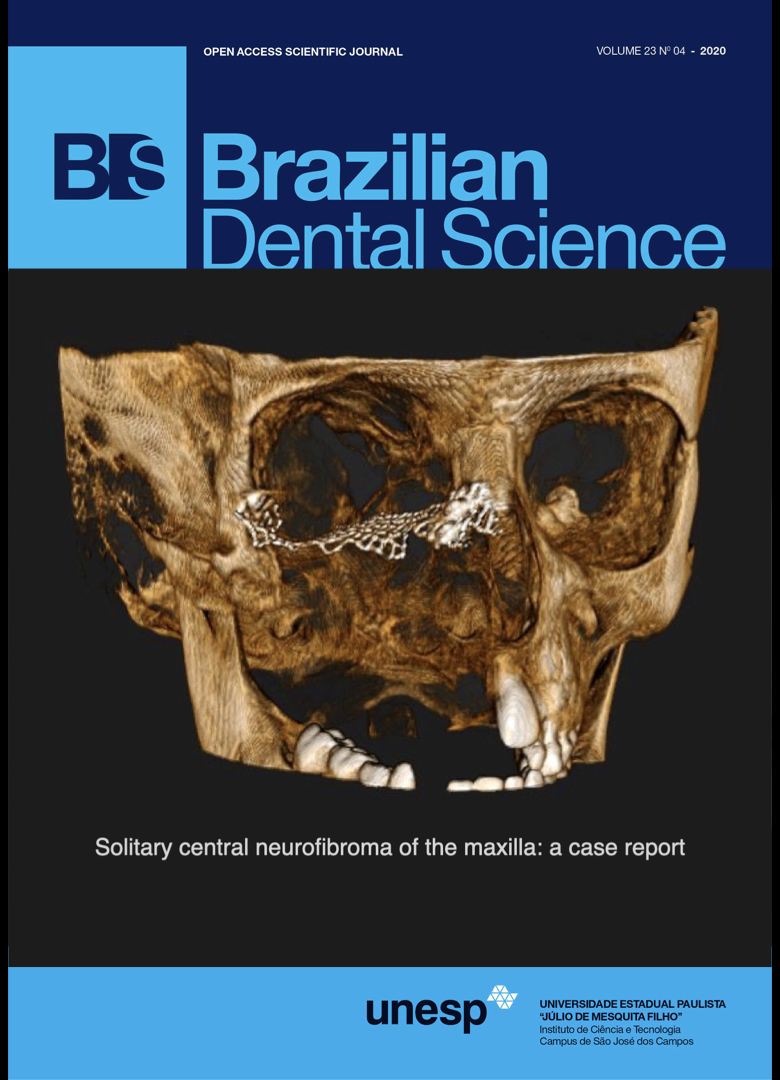Oral Candidiasis in Immunosuppressed Wistar Rats (Rattus norvegicus) Post Dexamethasone Injection at 7.2 mg/kg and 16 mg/kg Doses
DOI:
https://doi.org/10.14295/bds.2020.v23i4.2017Abstract
Objective: Oral candidiasis is an infection that occurs in the oral cavity and is caused by candida species, often Candida albicans. This infection commonly occurs in a condition of immunosuppression caused by dexamethasone. Due to the side effects of antifungal therapy, developing a standardized immunosuppressed animal model to induce oral candidiasis for new therapies is required. The aim of this study is to observe oral candidiasis in immunosuppressed Wistar rats post dexamethasone injection at 7.2 mg/kg and 16 mg/kg doses. Material and Methods: Twenty-one Wistar rats were divided into three groups: control group, treatment group 1 (injected with dexamethasone at a concentration of 7.2 mg/kg), and treatment group 2 (at a concentration of 16 mg/kg) for five days. Immunosuppression status was observed by leukocyte count and all the subjects’ palates were inoculated with C.albicans 0.1 ml of 15x108 UFC/ml 24 hours later. The subjects’ tongues were observed and confirmed by laboratory examination on day 10. A statistical analysis was performed using one way ANOVA, Kruskal–Wallis, Tukey HSD, and Mann-Whitney U tests. Results: A significant clinical appearance of the subjects’ tongues was observed only between C and T1 (p=0.023;p<0.05). Significant hyphal formation was observed between C and T1 (p= 0.037;p<0.05) and between C and T2 (p=0.007;p<0.05), and no significant difference was observed between T1 and T2. A significant increase in the colony count was also observed in similar results. Conclusion: Dexamethasone injection at doses of 7.2 mg/kg and 16 mg/kg is effective in triggering immunosuppression to induce oral candidiasis in immunosuppressed Wistar rats.
Keywords
Dexamethasone; Immunosuppression; Oral candidiasis.
Downloads
References
REFERENCES
Magare J, Awasthi R. Evaluating the Prevalence of Candida Species in the ral Cavity of Immunocompromised Patients. Int J Sci Res [Internet]. 2014;3(3):180–3.
Glick M, William M, Chair F. Burket’s Oral Medicine, 12th edition. USA: People’s Medical Publishing House; 2015. p.93
Sanchez A, Larsen R. Fungal infections in solid organ transplantation. Curr Opin Organ Transplant. 2007;12(6):579–84. doi: 10.1080/13693780701200372
Scully C. Handbook of oral disease. 1st edition London: Martin Dunitz; 1999. p.94
Elfaki MG, Hokail A, Kambal AM. Microbial Immunosuppression, Immunosuppression - Role in Health and Diseases, Dr. Suman Kapur (Ed.), ISBN: 978- 953-51-0152-9, In Tech, Available from: http://www.intechopen.com/books/immunosuppression-role-in-healthand-diseases/microbial-immunosuppression. 2012. pp. 215-224.
Kraaij MD, van der Kooij SW, Reinders MEJ, Koekkoek K, Rabelink TJ, van Kooten C. Dexamethasone increases ROS production and T cell suppressive capacity by anti-inflammatory macrophages. Mol Immunol. 2011;49(3):549–57. http://dx.doi.org/10.1016/j.molimm.2011.10.002
Rahayu RP, Prasetyo RA, Purwanto DA, Kresnoadi U, Iskandar RPD, Rubianto M. The immunomodulatory effect of green tea (Camellia sinensis) leaves extract on immunocompromised Wistar rats infected by Candida albicans. Vet World. 2018;11(6):765–70.
Takakura N, Sato Y, Ishibashi H, Oshima H, Uchida K, Yamaguchi H, et al. A novel murine model of oral candidiasis with local symptoms characteristic of oral thrush. Microbiol Immunol. 2003;47(5):321–6.
Park H, Myers CL, Sheppard DC, Phan QT, Sanchez AA, Edwards JE. Role of the fungal Ras-protein kinase A pathway in governing epithelial cell interactions during oropharyngeal candidiasis. Cell Microbiol. 2005;7(4):499–510. doi:10.1111/j.1462-5822.2004.00476.x
Vosooghi S, Mahmoudabady M, Neamati A, Aghababa H. Preventive effects of hydroalcoholic extract of saffron on hematological parameters of experimental asthmatic rats. Avicenna Journal of Phytomedicine. 2013; 3(3):279-287.
Alazzawi H, Ahmed JN. Assessment of oral sample col-lection technique for the isolation of Candida albicans from patients having denture stomatitis. Int J Sci Res 2017 Apr;6(4):1100 -1103
Faurie B. GRAM staining. 2019;(March):2–3. doi: 10.13140/RG.2.2.29711.84644
Gaona-Flores V, Quiróz-Guzmán R, Cervantes-Tovar R.M, Alcalá-Martínez E, Sandoval-Arrieta MI, Campos-Navarro LA. In vitro sensitivity to fluconazole through Vitek II systems, of strains of Candida spp. in patients with oropharyngeal candidiasis and HIV/AIDS. J. AIDS Clin. Res.2013, 4(8): 230. doi: 10.4172/2155-6113.1000230
Martinez A, Regadera J, Jimenez E, Santos I, Gargallo-Viola D. Antifungal Efficacy of GM237354, a Sordarin Derivative, in Experimental Oral Candidiasis in Immunosuppressed Rats. Antimicrobial Agents and Chemotherapy. 2001;45(4):1008-1013. doi: 10.1128/AAC.45.4.1008–1013.2001
Chami N, Chami F, Bennis S, Trouillas J, Remmal A. Antifungal treatment with carvacrol and eugenol of oral candidiasis in immunosuppressed rats. Brazilian Journal of Infectious Diseases. 2004;8(3).
Ohkaru Y, Arai N, Ohno H, Sato S, Sakakibara Y, Suzuki H et al. Acute and Subacute Effects of Dexamethasone on the Number of White Blood Cells in Rats. Journal Of Health Science. 2010;56(2):215-220.
François LM, Duncan W, Bernhard H. Candida albicans pathogenicity mechanisms. Virulence [Internet]. 2013;4(2):119–28. http://dx.doi.org/10.4161/viru.22913
Costa A, Pereira CA, Junqueira JC, Jorge AO. Recent mouse and rat methods for the studyof experimental oral candidiasis. Virulence 2013;4(5): 391–399. doi: 10.4161/viru.25199 •
Allen CM, Salfcr A, Meister RK, Beck FM, Btadway S. Comparison of a lesion-inducing isolate and a non-lesional isolate of Candida albicans in an immunosuppressed rat model of oral candidiasis. J Oral Palhol Med. 1994. 23. 133-9.
Coronado-Castellote L, Jimenez-Soriano Y. Clinical and microbiological diagnosis of oral candidiasis. Journal of Clinical and Experimental Dentistry. 2013; 5(5):279-86. doi: 10.4317/jced.51242
Dismukes W, Appas PMD, Sobel J. Clinical Mycology. Oxford: Oxford University Press; 2003. p.8
Regezi JA, Sciubba, James J, Jordan Richard CK. Oral Pathology: Clinical Pathologic Correlations, 5th ed. St. Louis: Linda Duncan; 2008. p.344
Wibawa T. The role of virulence factors in Candida albicans pathogenicity. J thee Med Sci. 2016;48(01):58–68.
Cheng SC, Joosten L, Kullberg BJ, Neteaa MG. Interplay between Candida albicans and the Mammalian Innate Host Defense. Journal ASM. 2012;80(4):1304–1313. DOI: 10.1128/IAI.06146-11
Downloads
Published
How to Cite
Issue
Section
License
Brazilian Dental Science uses the Creative Commons (CC-BY 4.0) license, thus preserving the integrity of articles in an open access environment. The journal allows the author to retain publishing rights without restrictions.
=================




























